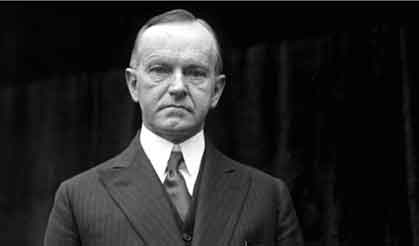CHAPTER 12
The Great Depression
There is probably no financial era in world history more famous than America’s Great Depression of the 1930s. It lasted longer, ran deeper, and had more long-lasting effects than any other financial calamity in the nation’s history, and the economic thinking shaped during that time dominates the world’s financial structure to this day.
The beginning of the Depression was flanked by two American presidents with vastly different turns of luck, based on their proximity to the event. On the one hand was Calvin Coolidge, who enjoyed a restful, crisis-free stay in the White House as the nation rollicked in the Roaring Twenties. The thriving economy was tagged as the “Coolidge prosperity,” even though the man for whom it was named had little or nothing to do with the happy circumstances at the time. He was fortunate to depart the White House in early 1929, untouched by the maelstrom that was soon to come (see Figure 12.1).
FIGURE 12.1 The taciturn Coolidge had the fortune of good timing, which permitted “Silent Cal” a relatively peaceful, stress-free tenure during his White House years.

On the other hand was Herbert Hoover, who, in spite of his best efforts, was widely regarded—particularly by his contemporaries—as hapless and ineffectual as the economic nightmare consumed much of the nation. Even today, the commonplace belief among those with a passing ...
Get Panic, Prosperity, and Progress: Five Centuries of History and the Markets now with the O’Reilly learning platform.
O’Reilly members experience books, live events, courses curated by job role, and more from O’Reilly and nearly 200 top publishers.

